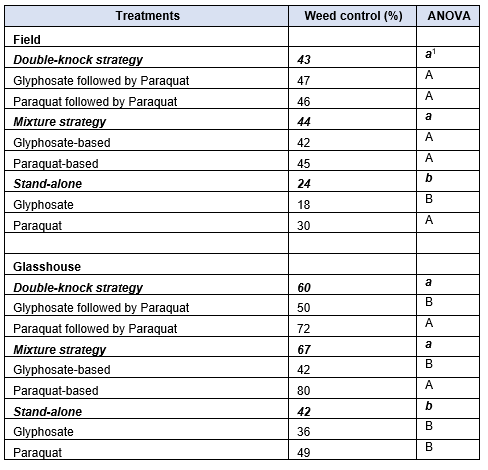How we best manage glyphosate and paraquat resistance in annual ryegrass
How we best manage glyphosate and paraquat resistance in annual ryegrass
Author: Roberto Busi, Brent Pritchard and Ken Flower | Date: 26 Feb 2024
Key messages
- Six cases of ryegrass highly resistant to glyphosate and paraquat have been detected infesting fence lines in Western Australia.
- Paraquat delivers significantly greater efficacy when mixed in combination with other modes of actions including herbicide mode of action: Groups 13, 14, 15, 34.
- Under controlled conditions some paraquat-based treatments delivered 100% efficacy and reversed resistance.
- Field management of this resistance is very challenging following its onset as the herbicide efficacy observed was significantly lower than expected.
Introduction
In Australia, annual ryegrass has evolved herbicide resistance to 12 different modes of action and the management of ryegrass with multiple resistance is a challenge for most grain growers. In 2022 and 2023, six ryegrass populations with multiple resistance to glyphosate and paraquat (and clethodim) were detected in the Albany Port Zone in Western Australia. Following the initial characterisation of resistance, two years (2022 and 2023) of intense field research occurred at two different locations (three field sites) and in parallel studies across those three populations with dual resistance to glyphosate and paraquat. The aim was to find a cost-effective herbicide solution to mitigate this type of resistance, which appears to be selected for on fence lines and then spreads into the cropped paddock.
Materials and methods
Three populations of annual ryegrass with a level of paraquat and glyphosate resistance (populations 501-22, 502-22 and 90-22) were sown in pots with four replications. Pots were sprayed with 30 different herbicide treatments in 2022 and 28 treatments in 2023. Field trials were conducted at the respective three field locations and herbicide efficacy was measured four weeks after treatments.
Herbicide kill rates were subjected to ANOVA with no transformation. GraphPad Prism (GraphPad Software, Inc., La Jolla, California) was used to analyse the data and ANOVA and t-test were used to compare kill rate of treatments/herbicide strategies.
Results
The results indicate that the populations studied were highly resistant to both glyphosate and paraquat with maximum field control of 18% and 30% with each stand-alone herbicide, respectively. The analysis indicated that, in the field, the double-knock and mixture strategy both significantly increased the control of resistant ryegrass. The double-knock with glyphosate followed by paraquat significantly improved the control over glyphosate stand-alone (Table 1). These results, despite the relatively low level of control observed, demonstrate the important role of paraquat and the double-knock strategy in managing emerging glyphosate resistance cases.
The work done in pots, under more controlled conditions, achieved better results and enabled a greater level of inference with an overall weed control efficacy significantly greater than that observed in the field (P<0.001). Results for both the field and glasshouse studies suggest that the double-knock and mixture strategies are significantly more effective than stand-alone and are therefore both good strategies to mitigate this type of multiple resistance. Specifically, double knock of paraquat followed by another paraquat appeared significantly more effective than a more classical double-knock with glyphosate followed by paraquat. If glyphosate efficacy is compromised by resistance then deploying a double-knock relying on glyphosate in the first knock does not appear to be an effective resistance-mitigation strategy.
Herbicide mixtures containing paraquat were consistently and significantly more effective than herbicide mixtures based on glyphosate (Table 1). We also found that a double-knock strategy with glyphosate followed by a treatment with paraquat was significantly more effective than herbicide mixtures containing only glyphosate added to another herbicide with residual ryegrass action. In a controlled glasshouse environment, herbicide mixtures with paraquat were significantly better than double-knock strategies of paraquat followed by paraquat (Table 1). This is probably explained by targeting plants at an earlier developmental stage with an effective paraquat-based mixture, instead of delivering such a mixture in a delayed treatment coinciding with the second knock.
In conclusion, overall resistance (i.e. the ability to survive, grow and set seed) to glyphosate and paraquat is dramatically reduced when paraquat is tank-mixed with a number of modes of action including Groups 13, 14, 15 and 34. Preliminary glasshouse work indicated a new herbicide registered in Australia in 2024 (indaziflam, group 29) can provide effective control of these dual glyphosate and paraquat resistant ryegrass populations (data not shown), although further field validation work is necessary.
This study documents a novel type of multiple resistance occurring in broadacre settings that is clearly challenging to manage. The study provides useful insights for herbicide stewardship and weed resistance management. Field trials in WA – where the dual paraquat and glyphosate resistance was found – will likely continue in 2024 to further refine our understanding and help mitigate an emerging weed resistance problem.
*Herbicide strategies including two types of double-knock (glyphosate followed by paraquat or paraquat followed by paraquat), several different mixtures of glyphosate or paraquat with herbicides from groups 13, 14, 15 or 34 were all compared with glyphosate or paraquat applied as a stand-alone treatment. Different letters in the ANOVA column indicate a significant difference established with Šídák's multiple comparisons test (P < 0.05).
1Different lower case bold letter show significant differences between strategies (e.g. double knock vs mixture) and upper case letters show significant differences within each strategy for “field” or “glasshouse” settings.
Acknowledgments
This work was co-funded by the GRDC (UWA2007-002RTX), COGGO, Bayer, FMC, Syngenta, Nufarm. The growers hosting the field trials are kindly acknowledged.
Contact
Roberto Busi
Australian Herbicide Resistance Initiative
roberto.busi@uwa.edu.au
GRDC Project Code: UWA2007-002RTX,

